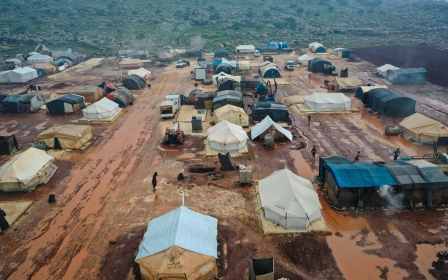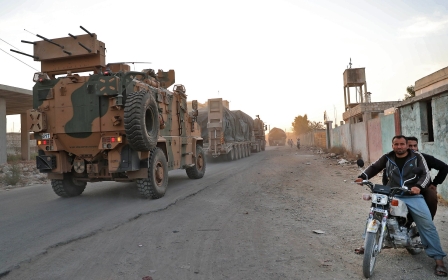In pictures: Camp fires add to the misery of displaced Syrians
Winter brings with it another danger for displaced Syrians living in the Idlib countryside - the threat of the cold. For the tens of thousands living in tented camps across northern Syria, keeping warm is as big a concern as a flare-up in fighting between opposition and government forces. But without adequate infrastructure, addressing even that most basic comfort presents a risk to life. If no heating is in place, temperatures inside the tents average around a couple of degrees Celsius and can fall to below zero. Many try to stay warm with makeshift furnaces that frequently spark tent fires, causing death and injury.
Tragically, Abdul Fattah al-Daghim knows the risks all too well. He lives in a tent near the town of Sarmada with his family after fleeing his native village of Jarjanaz, also in Idlib, due to the fighting. In January, his brother who lived in the tent next to him left a stove unattended. This sparked a fire that quickly spread to Abdul Fattah's dwelling. Abdul Fattah’s wife managed to escape with four of his children, but two of his daughters who were asleep at the time remained trapped inside. Abdul Fattah braved the fires to pull his children out from the flames, suffering burns to his face in the process. The children were rushed to a hospital in Turkey where one daughter, who was a year old, was admitted to intensive care and continues to receive treatment for her burn injuries. His daughter Yasmine, who was 10, died of her wounds soon after reaching the hospital.
According to her father, Yasmine loved learning and longed to return to the school in her village, where she said the classes were better than those in the camp. Abdul Fattah said all pictures of his daughter were destroyed in the fire, and the sole remaining image of her is the one taken of her lying in hospital shortly before she passed away, which he has kept alongside images of the aftermath of the tragedy.
Abdul Fattah’s brother Hani thinks that either high winds tipped the stove over, sparking the fire that killed his niece, or that the diesel used to fuel the stove may have leaked. The fire not only killed the child, but destroyed a motorbike and car belonging to the family, leaving them without a way to make a living. Such fires are common in camps housing Syrians across the region. They usually start accidentally, as a result of faulty heaters, poorly installed wiring, and water leaking into electric equipment. However, arson is also a cause, as was demonstrated by fires that destroyed 100 tents housing refugees in neighbouring Lebanon.
White Hands, a local NGO working in the camp, has provided Abdul Fattah with some help. It gave his family essentials, such as mattresses, blankets, food, cooking gas canisters, and safer wood-based furnaces, so they could start over. While grateful for the help he has received, Abdul Fattah said the only real solution to the dangers of living in a tent was to return to their homes in safety or to get rehoused in safer accommodation.
Syria’s civil war started nearly a decade ago and has since uprooted millions of people, with around 6.6 million refugees, who have fled the country, and a further 6.1 million, who are internally displaced. No accurate figures exist for the number of those who have been killed during the war, but as of 2018, there were at least half a million fatalities.
There is little data on how many fires have occurred in the camps, as many incidents go unreported and are dealt with on an ad-hoc basis by camp residents and NGOs working with the displaced. The cases are, however, frequent enough for aid workers to make teaching residents about fire safety a priority. Abdul Raouf Salloum, of the Said Charitable Association, said his organisation was providing camp residents with safer equipment and teaching them to take precautionary measures, such as carrying out regular temperature checks on heaters and ensuring proper ventilation.
The northwestern corner of Syria remains under opposition control after 10 years of conflict. Many of those living there have been displaced from other parts of Syria. As recently as February 2020, the region was on the verge of a humanitarian crisis as Syrian government forces advanced on rural Idlib. More than 700,000 found themselves trying to flee the fighting. Many of those have ended up in camps like the one Abdul Fattah lives in.
Middle East Eye propose une couverture et une analyse indépendantes et incomparables du Moyen-Orient, de l’Afrique du Nord et d’autres régions du monde. Pour en savoir plus sur la reprise de ce contenu et les frais qui s’appliquent, veuillez remplir ce formulaire [en anglais]. Pour en savoir plus sur MEE, cliquez ici [en anglais].




